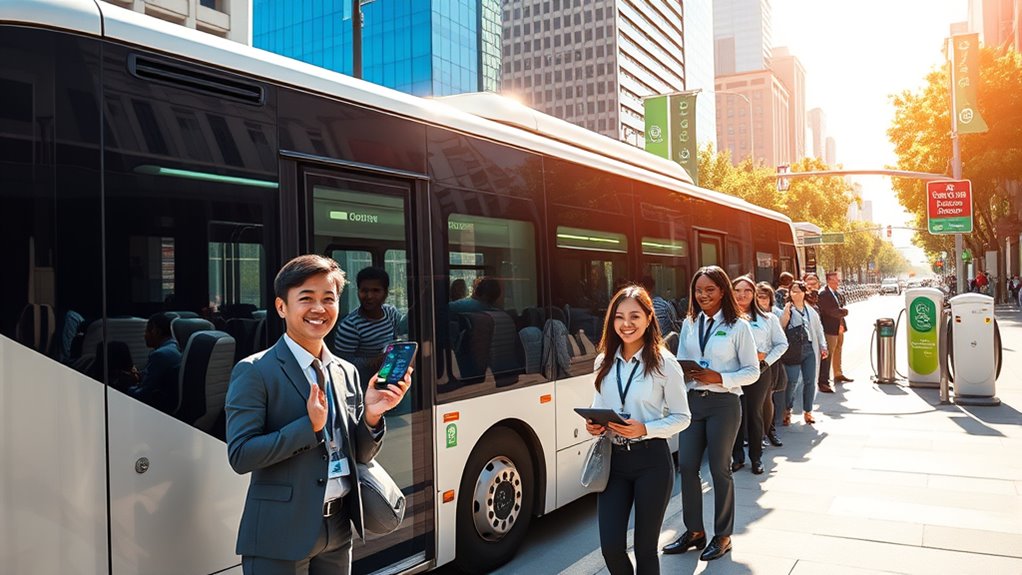Many electric bus operators, like Antelope Valley Transit Authority and Shenzhen, showcase the success of full electrification, cutting emissions and improving efficiency. Cities such as Seoul and clients at major airports implement large fleets with smart charging and innovative infrastructure, proving electric buses are practical for large-scale transit. These stories highlight how technology advances and strategic partnerships accelerate adoption. Keep exploring to discover how these successes could inspire your own transportation solutions.
Key Takeaways
- Antelope Valley Transit Authority became North America’s first 100% electric transit agency, demonstrating full fleet electrification success.
- Shenzhen pioneered all-electric public buses in 2018, showcasing large-scale adoption and operational reliability.
- The deployment of electric buses at major airports like LAX and Tampa improves sustainability and reduces emissions.
- Industry partnerships, like The Mobility House, have built large, advanced charging infrastructure supporting successful operations.
- Technological innovations, such as improved e-axle efficiency, enhance performance and cost-effectiveness for electric bus operators.

Electric buses are transforming urban transportation worldwide, showcasing how cities and operators are embracing cleaner, more efficient mobility solutions. Shenzhen leads the way, becoming the first city in 2018 with an all-electric public bus fleet. This milestone proves that large-scale electrification is achievable and sets a powerful example for other cities. Following Shenzhen’s model, many urban areas worldwide are adopting electric buses to create cleaner, healthier environments.
Seoul has announced plans to replace 3,000 natural gas buses with electric models by 2025, demonstrating a strong commitment to sustainable transit. China remains the dominant force in electric bus manufacturing and deployment, fueling global growth and innovation in this sector. These efforts aren’t just about reducing emissions; they also improve air quality, making urban spaces more livable.
Key players like The Mobility House and NFI Infrastructure Solutions are leading the charge in developing smart charging solutions. They’ve collaborated on multiple projects, including building the largest charging depot in North America for St. Louis Metro in 2020. This infrastructure supports larger fleets and guarantees buses stay operational without interruption.
The Antelope Valley Transit Authority stands out as the first 100% electric transit agency in North America, showing that full electrification is within reach for even large-scale systems. As these agencies expand their fleets, they’re building new depots and adopting innovative charging technology, streamlining operations and reducing downtime.
Technological innovations are also driving success. Parker’s GVM solution has improved e-axle efficiency by over two percent, enhancing performance and lowering energy consumption. Advances in electric axle designs and smart charging systems make electric buses more practical and cost-effective.
These improvements boost adoption rates, as transit agencies see real benefits in reliability and savings. Developing dependable infrastructure is essential, and ongoing efforts to standardize charging technology promote compatibility across different bus models. Industry partnerships play a significant role in expanding and upgrading infrastructure, making electric bus fleets more scalable and easier to manage.
In airports, electric buses are gaining ground as well. Kansas City International Airport, LAX, and Tampa International Airport have incorporated electric buses into their passenger transport, reducing emissions and aligning with sustainability goals.
These successes demonstrate that electric buses can deliver not only environmental benefits but also operational efficiencies, cost savings, and positive public perception. Governments worldwide are supporting these transitions through incentives and regulations, further accelerating adoption.
Frequently Asked Questions
What Are the Initial Costs of Switching to Electric Buses?
Switching to electric buses involves high initial costs, averaging around $352,000 per bus, which is more than diesel options.
You’ll also need to invest in charging infrastructure, costing between $10,000 and $30,000.
While these upfront expenses are significant, you can reduce them through grants, partnerships, and incentives.
Keep in mind that lower maintenance and operational costs may help offset the initial investment over time.
How Do Maintenance Costs Compare to Diesel Buses?
You’ll find that maintenance costs for electric buses are generally lower than for diesel buses. Electric models have fewer moving parts, so there’s less that can break or wear out.
You’ll spend less on brake repairs thanks to regenerative braking, and electric motors last longer with less upkeep.
What Charging Infrastructure Is Required for Electric Buses?
You need the right charging infrastructure to support electric buses effectively. Options include pantograph, inductive, plug-in, and fast chargers, each suited for different needs.
You’ll require substantial power capacity, often up to 10 MW for large fleets, and infrastructure upgrades like sub-stations.
Planning involves considering charging times, costs, and utility coordination to guarantee buses are charged efficiently and reliably, minimizing operational disruptions.
How Do Electric Buses Perform in Extreme Weather Conditions?
You might wonder how electric buses handle extreme weather. In cold conditions, they operate well with some adjustments, though range can drop due to heating needs.
In hot weather, proper testing and route planning help maintain performance, while high temperatures can impact batteries.
Regular maintenance, preheating or cooling, and monitoring forecasts ensure your buses stay reliable, no matter the weather.
Proper strategies make all the difference for peak electric bus performance.
What Government Incentives Are Available for Electric Bus Operators?
You can access various government incentives to support your electric bus operations. These include purchase grants that lower upfront costs, operational support like reduced charging rates, and assistance with installing charging infrastructure.
Tax credits of up to $40,000 per bus are available, along with grants from federal and local programs. These incentives help reduce emissions, save on fuel and maintenance, and promote faster adoption of electric buses in your fleet.
Conclusion
By embracing electric buses, you can transform your fleet and reduce emissions. Imagine a city where your buses run quietly, cost less to operate, and boost community pride—just like Green City Transit, which cut costs by 30% and improved air quality. Your success story is waiting to be written, and electric buses could be the game-changer you need. Take the leap, and see how clean, efficient transportation can revolutionize your operations!








